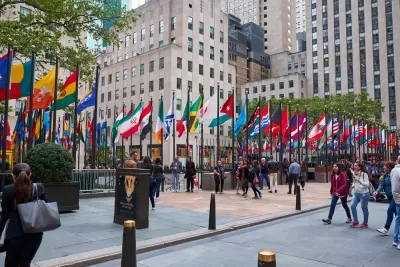New York City officials, including Mayor Bill de Blasio, are responding to a wave of terrorist attacks and other tragic events with a proposal to build protective bollards around the city.

"Hundreds of new protective barriers will be permanently installed in Times Square and other locations around New York in an effort to block vehicles from hitting pedestrians after deadly attacks last year on crowds," reports CBS News.
The city will spend $50 million on the project, a figure ridiculed by some on Twitter as an example of New York's tendency to over spend on infrastructure. With 1,500 the target number of bollards announced by Mayor Bill de Blasio, the project works out to over $33,000 a bollard. Following up on the official announcement, Vincent Barone offered more detail about the costs of the project on Twitter.
Clarification on costs of de Blasio’s bollard plan: the $50M will in fact pay for 1,500 bollards. Mayor’s spox said most will be metal bollards, but others might be geometric structures, etc. Costs are high because some bollards will require moving underground ifnra, he said.
— Vincent Barone (@vinbarone) January 2, 2018
Specific details about where the new bollards will be located were also scant. "City officials didn't specify what other locations will be fortified, beyond the bike path and Times Square, but said there would be barriers set up in all five boroughs," according to CBS News.
CBS News also recounts the chronology of tragic events leading to the project, including the November terrorist attack on the Hudson River Bikeway and the Bastille Day terror attack in Nice, France.
[Update] The Village Voice has published an article by Jake Offenhartz that expresses a healthy dose of skepticism about the efficacy and cost effectiveness of the program.
FULL STORY: New York City to install 1,500 protective barriers after vehicle attacks

Alabama: Trump Terminates Settlements for Black Communities Harmed By Raw Sewage
Trump deemed the landmark civil rights agreement “illegal DEI and environmental justice policy.”

Planetizen Federal Action Tracker
A weekly monitor of how Trump’s orders and actions are impacting planners and planning in America.

The 120 Year Old Tiny Home Villages That Sheltered San Francisco’s Earthquake Refugees
More than a century ago, San Francisco mobilized to house thousands of residents displaced by the 1906 earthquake. Could their strategy offer a model for the present?

In Both Crashes and Crime, Public Transportation is Far Safer than Driving
Contrary to popular assumptions, public transportation has far lower crash and crime rates than automobile travel. For safer communities, improve and encourage transit travel.

Report: Zoning Reforms Should Complement Nashville’s Ambitious Transit Plan
Without reform, restrictive zoning codes will limit the impact of the city’s planned transit expansion and could exclude some of the residents who depend on transit the most.

Judge Orders Release of Frozen IRA, IIJA Funding
The decision is a victory for environmental groups who charged that freezing funds for critical infrastructure and disaster response programs caused “real and irreparable harm” to communities.
Urban Design for Planners 1: Software Tools
This six-course series explores essential urban design concepts using open source software and equips planners with the tools they need to participate fully in the urban design process.
Planning for Universal Design
Learn the tools for implementing Universal Design in planning regulations.
Clanton & Associates, Inc.
Jessamine County Fiscal Court
Institute for Housing and Urban Development Studies (IHS)
City of Grandview
Harvard GSD Executive Education
Toledo-Lucas County Plan Commissions
Salt Lake City
NYU Wagner Graduate School of Public Service




























